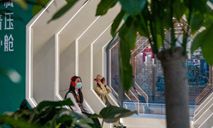Archaeology museum offers public closer look at history
XI'AN, May 2 (Xinhua) -- Yang Bin, a university student in northwest China's Shaanxi Province, didn't expect that he could touch the fragments of prehistoric pottery displayed in a museum.
Visitors, including Yang, to the newly opened Shaanxi Archaeology Museum, located in Xi'an, the capital of Shaanxi, were amazed by the different experiences of feeling the texture of actual cultural relics like archaeologists.
Featuring China's modern archaeology, the museum is built based on achievements of field archaeological excavation projects and research on relic preservation technologies made by the Shaanxi Academy of Archaeology over the past six decades.
The museum provides visitors a glimpse of technology-assisted archaeological work via the restoration of excavation sites, carefully-placed interpretations, and interactive devices. It offers a closer look at these treasures and a deeper understanding of history.
Among the over 5,200 pieces of relics on display, most are exhibited to the public for the first time.
An exquisite headgear dating to the Tang Dynasty (618-907) decorated with gold, silver, pearls, and jade has hogged the limelight. It is the first headgear in that dynasty successfully restored in China.
Next to it, four pictures show the scenes when it was first discovered. The headgear was scattered beside a skeleton and broken into hundreds of pieces overlaid with each other. Archaeologists brought them all into the laboratory.
With the help of micrographs, archaeologists located the original position of each fragment and restored them layer by layer. The whole process is elaborated to visitors in words and pictures. Excavation tools and a microscope for the restored headgear are also on display.
This headgear is also the first to be restored through laboratory microscopic technologies in China.
Another eye-catching exhibit is a bronze chariot dating from the Western Zhou Dynasty (1046-771 B.C.).
Unearthed in the Zhouyuan site, Baoji City, the bronze chariot was a luxurious vehicle for dignitaries. The wheels are bronze, and the carriage is decorated with hundreds of bronze components inlaid with turquoise.
Archaeologists "packaged" the whole excavation site to the laboratory and spent three years cleaning and restoring the chariot. The entire site is now on display in the museum.
"3D models, touch screens, and other interactive devices in the museum can demonstrate extensive information about the archaeological research, the history, and the arduous work done by archaeologists," said Hu Xiaoyu, director of the exhibition department of the museum.
"The museum gathers archaeological excavations, relics preservation, exhibitions, and public education together to offer the public a closer look at archaeological research and our achievements in the field," said Sun Zhouyong, curator of the museum.
Photos
Related Stories
- Exhibition featuring marine civilization of South China Sea held at Hainan Museum
- Chinese museums overcome geographical boundaries after holding online exhibitions
- People visit exhibitions at Times Art Museum in Beijing
- Sneak peek of conceptual design of New Sanxingdui Museum
- Mimara Museum illuminated during Festival of Lights in Zagreb, Croatia
- Chengdu Museum showcases costumes featuring Silk Road culture
- Nanjing city wall museum opens for trial service
- Shenyang Museum opens for visitors
- People visit industrial museum in Chongqing
- Qinghai Provincial Museum showcases new exhibits featuring valuable cultural relics, archaeological discoveries
Copyright © 2022 People's Daily Online. All Rights Reserved.










